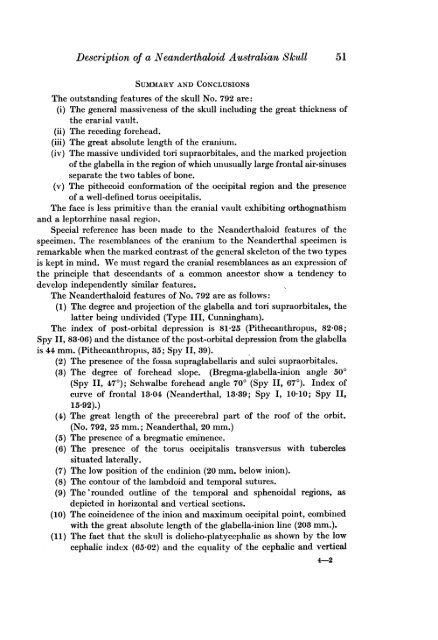THE DESCRIPTION OF A NEANDERTHALOID AUSTRA-
THE DESCRIPTION OF A NEANDERTHALOID AUSTRA-
THE DESCRIPTION OF A NEANDERTHALOID AUSTRA-
Create successful ePaper yourself
Turn your PDF publications into a flip-book with our unique Google optimized e-Paper software.
Description of a Neanderthaloid Ausstralian Skull<br />
SUMMARY AND CONCLUSIONS<br />
The outstanding features of the skull No. 792 are:<br />
(i) The general massiveness of the skull including the great thickness of<br />
the cranial vault.<br />
(ii) The receding forehead.<br />
(iii) The great absolute length of the cranium.<br />
(iv) The massive undivided tori supraorbitales, and the marked projection<br />
of the glabella in the region of which unusually large frontal air-sinuses<br />
separate the two tables of bone.<br />
(v) The pithecoid conformation of the occipital region and the presence<br />
of a well-defined torus occipitalis.<br />
The face is less primitive than the cranial vault exhibiting orthognathism<br />
and a leptorrhine nasal region.<br />
Special reference has been made to the Neanderthaloid features of the<br />
specimen. The resemblances of the cranium to the Neanderthal specimen is<br />
remarkable when the marked contrast of the general skeleton of the two types<br />
is kept in mind. We must regard the cranial resemblances as an expression of<br />
the principle that descendants of a common ancestor show a tendency to<br />
develop independently similar features.<br />
The Neanderthaloid features of No. 792 are as follows:<br />
(1) The degree and projection of the glabella and tori supraorbitales, the<br />
latter being undivided (Type III, Cunningham).<br />
The index of post-orbital depression is 81'25 (Pithecanthropus, 82-08;<br />
Spy II, 83.06) and the distance of the post-orbital depression from the glabella<br />
is 44 mm. (Pithecanthropus, 35; Spy II, 39).<br />
(2) The presence of the fossa supraglabellaris and sulci supraorbitales.<br />
(3) The degree of forehead slope. (Bregma-glabella-inion angle 500<br />
(Spy II, 470); Schwalbe forehead angle 700 (Spy II, 670). Index of<br />
curve of frontal 13-04 (Neanderthal, 13-39; Spy I, 10-10; Spy II,<br />
15.92).)<br />
(4) The great length of the precerebral part of the roof of the orbit.<br />
(No. 792, 25 mm.; Neanderthal, 20 mm.)<br />
(5) The presence of a bregmatic eminence.<br />
(6) The presence of the torus occipitalis transversus with tubercles<br />
situated laterally.<br />
(7) The low position of the endinion (20 mm. below inion).<br />
(8) The contour of the lambdoid and temporal sutures.<br />
(9) The 'rounded outline of the temporal and sphenoidal regions, as<br />
depicted in horizontal and vertical sections.<br />
(10) The coincidence of the inion and maximum occipital point, combined<br />
with the great absolute length of the glabella-inion line (203 mm.).<br />
(11) The fact that the skull is dolicho-platycephalic as shown by the low<br />
cephalic index (65.02) and the equality of the cephalic and vertical<br />
4-2<br />
51

















